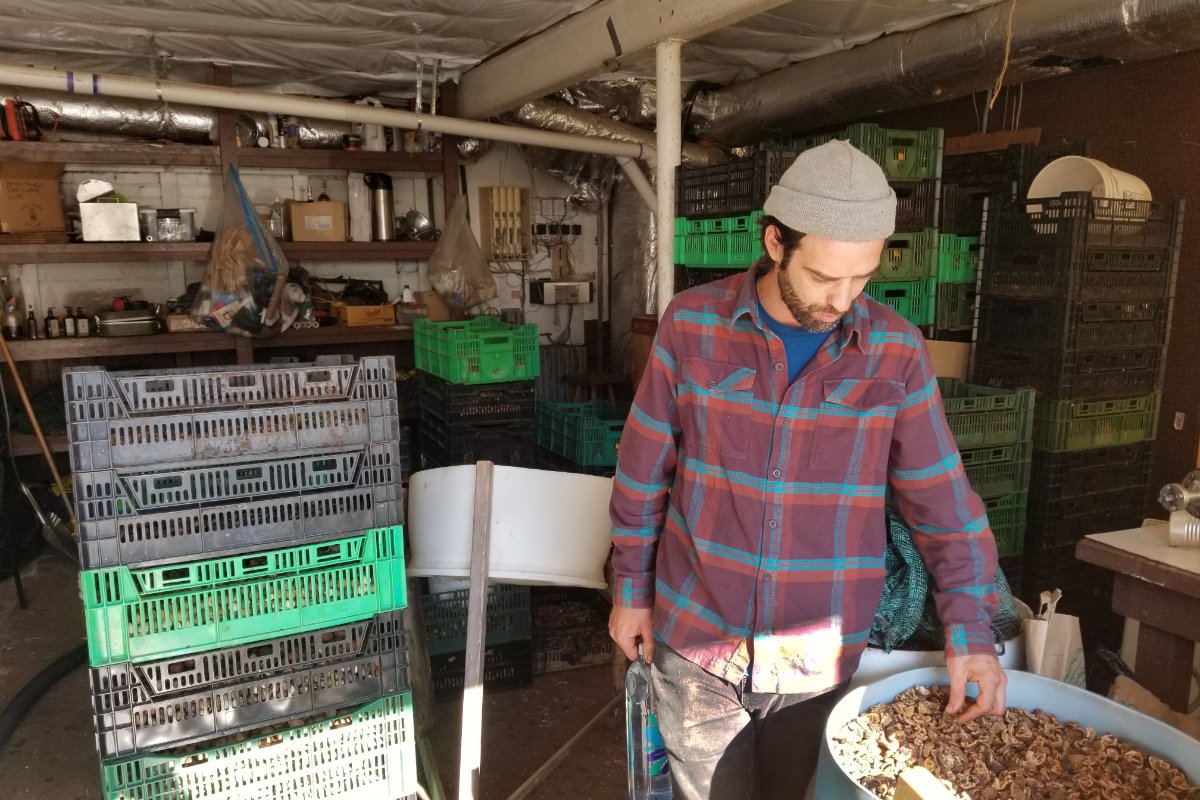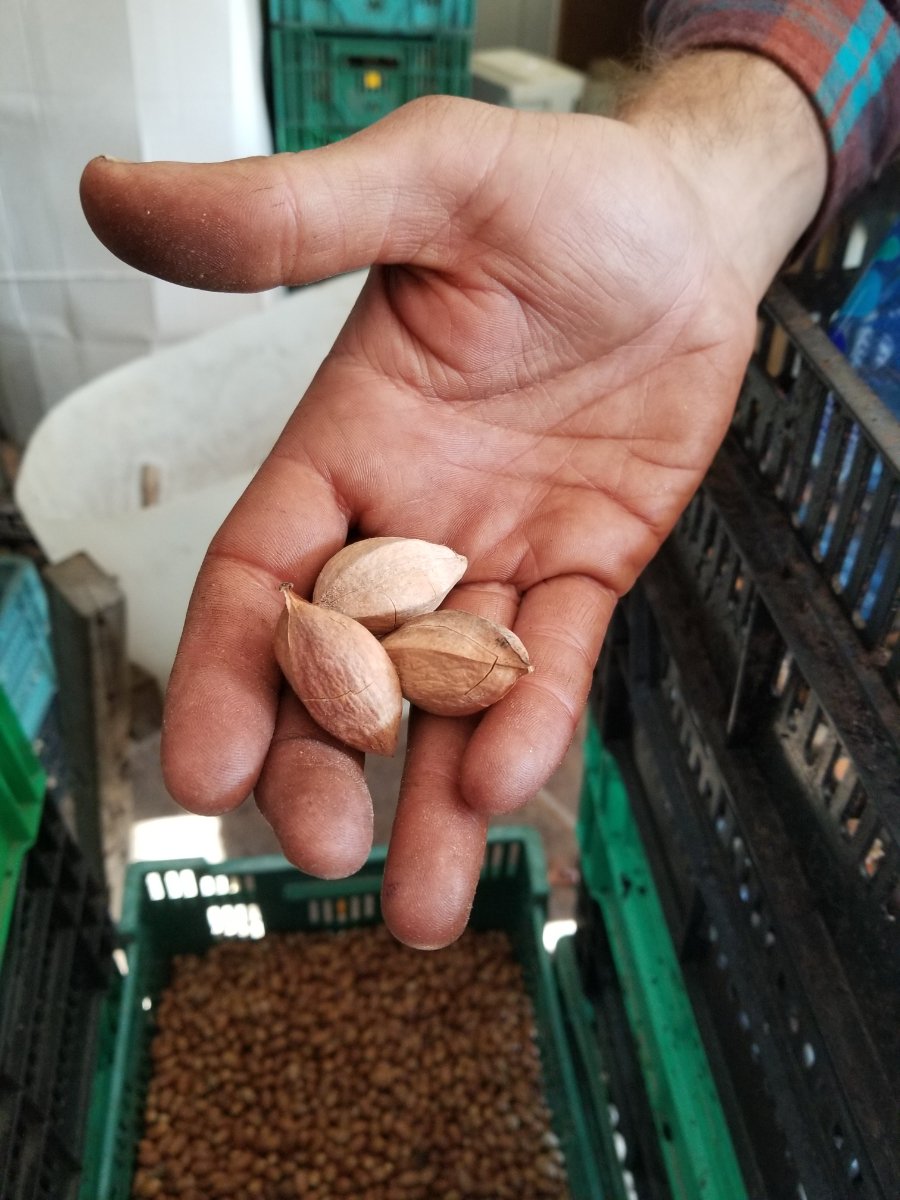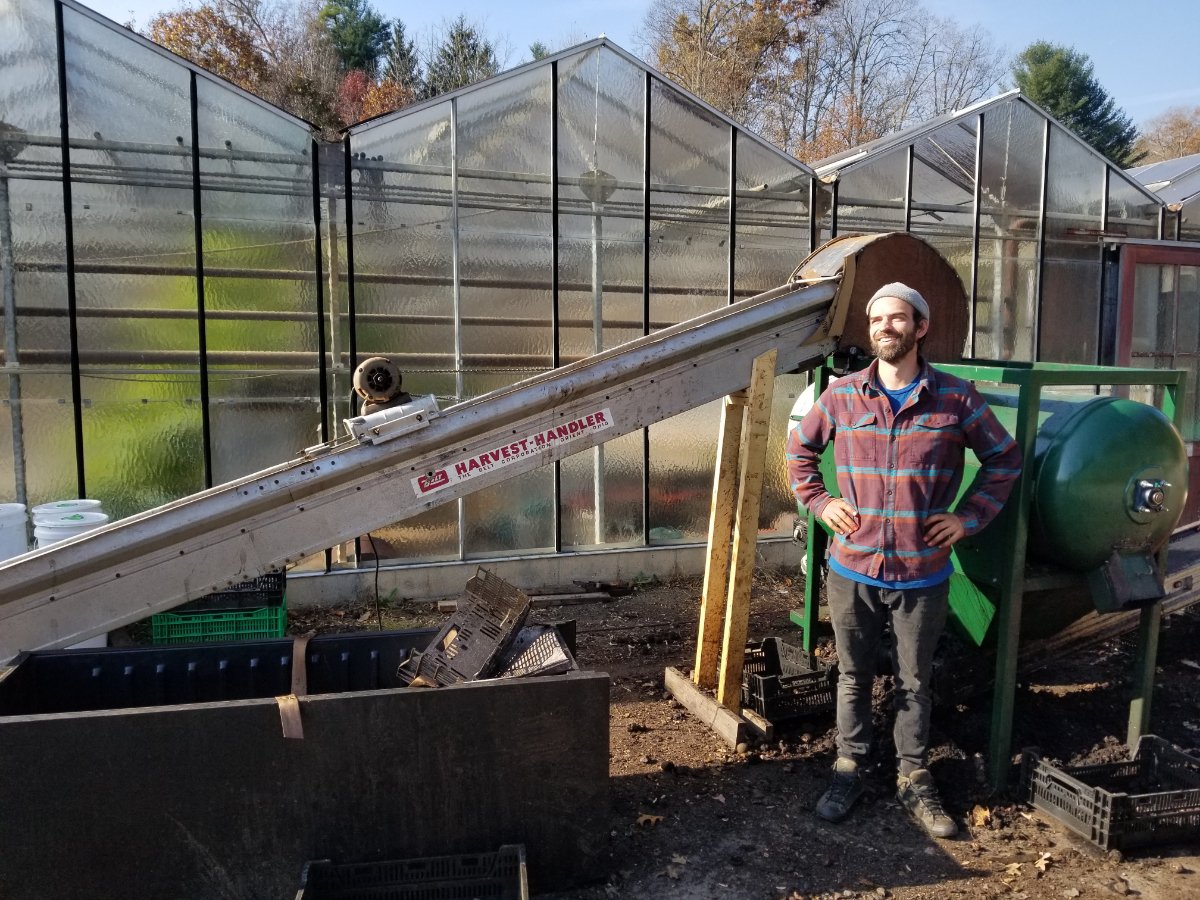The Asheville Nuttery and its partners see untapped potential in wild tree crops like acorn and black walnut, often considered a nuisance to the uninitiated.

The Asheville Nuttery and its partners see untapped potential in wild tree crops like acorn and black walnut, often considered a nuisance to the uninitiated.
December 19, 2023

Nuts dry in plastic bins at the Asheville Nuttery storeroom as Justin Holt examines a barrel of walnut shells. The hard material has a number of valuable uses, including sandblasting abrasive, kitty litter, and biochar feedstock. (Photo credit: Daniel Walton)
As Justin Holt comes in for a handshake on a bright morning in early November, it’s hard not to notice the color of his palms. They’re the hue of fine wooden furniture, a warm, ruddy tone that is considerably darker than the wrists that peek out from the long sleeves of his broad-checked flannel shirt.
Holt smiles as he turns his hands outward. “They’re going to be brown like this through Christmas,” he says. The rich stain was a natural consequence of how Holt spent his fall: processing thousands of pounds of black walnuts through the Asheville Nuttery.
Black walnut trees are a common sight across Western North Carolina and much of Southern Appalachia. Their canopies spread tall and broad, with long, pointed leaves that turn a vibrant yellow in the fall. And they’re abundant producers of greenish-yellow fruit, each about the size of a tennis ball and containing a wrinkly brown nut.
Yet for many in the area, black walnuts are more problem than produce. Their hulls cling tenaciously to the nut and, as Holt’s hands attest, stain almost everything they touch. Their shells are harder and thicker than those of the English walnut, the most common commercially cultivated species, and are difficult to separate from the kernel within. Suburbanites with walnut trees often treat the nuts as trash, gathering them up only for disposal to maintain a clear lawn.
Holt and his partners at the Asheville Nuttery, Bill Whipple and Greg Mosser, are trying to shift that perception. Since 2017, the cooperative has been piloting new ways to collect, process, and market tree crops, with the goal of catalyzing a local nut-based economy.
Walnuts are just the beginning, says Holt, as he walks into the Nuttery’s storeroom. The converted garage is chockablock with green and black plastic bins, each holding a bevy of nuts being dried for the future.
“It’s a different feeling to inhabit the landscape in a way where you’re paying attention to what gifts are available right around any corner. It turns your life into an Easter egg hunt—it brings the landscape to life in a way that is pretty thrilling.”
Pin oak and black oak acorns can be pressed to extract a bright orange oil that tastes of caramelized butter. Mockernut and shagbark hickories, when pounded and simmered in water, yield a milk Holt describes as “liquid banana-nut bread.” The Nuttery works with at least a dozen different species, although walnuts are by far the most prevalent by weight.
By encouraging people to see the value in their native trees, the Nuttery hopes to inspire parallel efforts across the region. Creating outlets for community-scale nut crops, Holt suggests, could incentivize landowners to keep their existing trees or plant new ones, agroforestry practices that might help them mitigate and adapt to climate change.
Just as importantly, believes Holt, embracing wild nuts can transform how residents experience their environment. “It’s a very different kind of feeling to inhabit the landscape in a way where you’re paying attention to what gifts are available right around any corner,” he explains. “It feels kind of like it turns your life into an Easter egg hunt—it brings the landscape to life in a way that is pretty thrilling.”
Such a view of nut trees in the South was once much more widespread. The Cherokee people native to the region have historically gathered and eaten a wide variety of wild nuts, including the American chestnut, now all but gone from the forest due to a blight introduced in the late 1800s through imported Japanese chestnuts. European settlers also made use of wild tree crops, particularly black walnuts, and Holt says numerous companies processed and sold them through the middle of the 20th century.
Given their labor-intensive harvest and processing requirements, however, wild nuts largely fell out of favor as the country’s food system became more industrialized and commercial U.S. nut production became concentrated in California. One firm—the Stockton, Missouri-based Hammons Product Company, which still relies on hand-harvested wild black walnuts—is essentially all that’s left of the old nut economy.
Hammons used to collect black walnuts at a station in Western North Carolina, remove the hulls, and ship the nuts to Missouri for further processing. The company pulled out of Appalachia several years ago due to insufficient volumes, says Holt; the nearest of Hammons’ 200-plus collection stations is now in Spring City, Tennessee, well over a three hours’ drive away.
The Asheville Nuttery aims to process at least 20,000 pounds of black walnuts this year, along with thousands of pounds of other species. That scale would fill the gap between the national reach of Hammons, which expects to purchase over 15 million pounds of walnuts this year, and someone processing a few nuts from their backyard for a cake.
But without a model to follow or ready-made tools to purchase, trying to make that scale economical has meant a lot of trial and error. Holt, who also works as an independent permaculture consultant and a guide for the foraging tour company No Taste Like Home, says the cooperative’s members haven’t yet paid themselves from Nuttery activities.

Justin Holt shows off a handful of hickory nuts, which he says yield a milk similar to “liquid banana-nut bread.” (Photo credit: Daniel Walton)
The Nuttery recently invested in an optical sorter to speed up tasks like sifting caps and shell fragments away from cracked acorns. And it made a major leap forward in efficiency by developing its own commercial-scale walnut huller, supported by a $10,000 grant from a regional foundation. Holt says he chanced upon an expired 1958 patent by inventor Clovis Packwood, which provided the basic design, then tweaked and iterated with the help of local fabricator Dan Hettinger.
The resulting contraption consists of a big green metal drum, which is fed a constant stream of walnuts from a conveyer belt. “There’s a shaft that runs through the middle with chains welded on in a spiral pattern,” Holt explains. “The chains advance the nuts down the chamber, all the while kind of spanking the hulls off.”
Roughly 500 pounds of hulled walnuts emerge from the machine every hour at full capacity, nearly quadruple the rate of the Nuttery’s previous process. Holt hopes to further refine the design before making plans available to other community-scale groups or producing more hullers for sale, but he’s happy to share what he’s learned so far.
Zev Friedman, whose nonprofit Cooperate WNC served as the fiscal sponsor for the walnut huller grant, says the Nuttery’s efforts are laying critical groundwork for processors to come. “They’re creating new equipment, new processing methods and food types,” he says. “They’ve done a huge amount of research and development, most of which is open-source.”
As the Nuttery solves its processing challenges, it’s also working to restore the cultural perception of wild nuts as food—both among foragers who can harvest raw materials and customers who can buy finished products. There have been successes on each front.
Like Hammons, the Nuttery doesn’t gather its own nuts but buys them from anyone interested in collecting them. Foragers earn at least 20 cents per pound for black walnuts, with bonuses for higher volumes; the smaller and more finicky acorns can fetch up to $2 per pound. Holt says roughly 100 people from across the region are now contributing nuts, more than double the number of those involved at the project’s start.
One recent recruit is Mitzi Aoyagi, an Asheville-based massage therapist. Although she is a longtime forager of mushrooms and medicinal plants, she says she knew next to nothing about oaks until she started to gather acorns for the Nuttery this fall. She stuffed her pockets to bursting several times a day as she walked her dogs beneath her neighborhood trees.
“I didn’t even think of acorns as nuts before,” she says with a laugh. “Now, there are bowls of acorns all over my house!”
Instead of cash, Aoyagi is trading her acorns for the promise of cooking and baking supplies at the end of the season. She’s excited by the potential of wild nuts to yield locally sourced oil and high-protein flour. “For me, it’s like making treasure out of what other people consider trash, and I love that,” she says.
To help spread that excitement about new ingredients, the Nuttery has been turning to restaurateurs and bakeries. Nashville-based, James Beard award-winning chef Sean Brock has helped introduce many people to acorn and black walnut products, says Holt, as has Asheville’s OWL Bakery.
Once people get a taste, they’re eager to buy more: The Nuttery has sold about $8,000 in shares of its “TreeSA,” a community-supported agriculture program for nut products that it launched this fall, and Holt says it’s on pace to break $10,000 by year’s end.
Another strategy, as employed by Nuttery partner Whipple, is incorporating nuts into existing culinary products. He points to the pancake and cornbread mixes he’s producing with Virginia-based Deep Roots Milling, each of which contains about 20 percent foraged acorn flour.
While customers might not know how to cook with acorn flour alone, Whipple explains, the mixes give them an easy introduction to its flavor. Perhaps ironically, the mixes have sold best not in rural Virginia but at markets in Washington, D.C.
“They’re in the suburbs or in townhouses, and they need to take in some wildness,” he suggests of those customers. “Acorn is a wildness supplement—Vitamin W.”
If the Asheville Nuttery can establish an economically viable model for local nut processing, its partners imagine a network of similar facilities throughout Appalachia. Whipple has been evangelizing about that vision through his Acornucopia Project since before the Nuttery was even founded.
The yields of wild nuts can vary considerably between places and seasons, Whipple points out. Some years a region’s trees put out a bumper crop, a phenomenon known as mast seeding, while other years can see very little production. While weather and available nutrients are thought to play a role, scientists still don’t completely understand what triggers mast.

Justin Holt stands by the commercial-scale walnut huller the Asheville Nuttery developed with help from local fabricator Dan Hettinger. (Photo credit: Daniel Walton)
Processors located in different regions could help each other smooth out the vagaries of these cycles by trading nuts and products. “With how decentralized mast is, and it’s meant to be that way, it necessitates community,” Whipple says.
Robust processing capacity could also encourage those who own land to establish new orchards planted with under-appreciated species. The same team behind the Nuttery set up the Nutty Buddy Collective to coordinate and support new plantings, with landowners signing long-term leases in exchange for a share of the yields. Whipple suggests the model could be a good fit for land under conservation easements, offering owners an income stream that doesn’t require felling trees for timber or annual crop fields.
And in existing forests, the economic support created by a nut market could help shape more resilient management practices. The region’s woods have historically been dominated by oaks and hickories, Holt says, a legacy of careful Indigenous land management. But 20th century attitudes toward fire suppression led to greater competition from shade-tolerant, lower-value species.
Clearing those trees through controlled burns and other methods and replanting nut crops, he believes, would lead to a healthier landscape. Actively regenerating forests sequester more carbon and can help communities better resist large wildfires, which are likely to become more common throughout the Southeast as the climate changes. Like eating wild nuts itself, Holt says, such an approach to forestry would represent a return to older patterns of life.
“I think it’s important for us to get back to that place,” he says. “Not just from the perspective of what is morally or ethically correct, but in terms of what has worked to support human survival and thriving.”

October 9, 2024
In this week’s Field Report, MAHA lands on Capitol Hill, climate-friendly farm funding, and more.
October 2, 2024

October 2, 2024

October 1, 2024

September 30, 2024

September 25, 2024

September 25, 2024

Like the story?
Join the conversation.